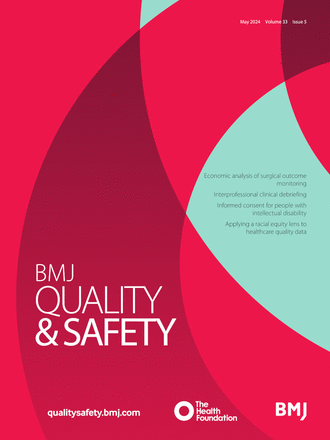General practitioners’ risk literacy and real-world prescribing of potentially hazardous drugs: a cross-sectional study
IF 5.6
1区 医学
Q1 HEALTH CARE SCIENCES & SERVICES
引用次数: 0
Abstract
Background Overuse of medical care is a pervasive problem. Studies using hypothetical scenarios suggest that physicians’ risk literacy influences medical decisions; real-world correlations, however, are lacking. We sought to determine the association between physicians’ risk literacy and their real-world prescriptions of potentially hazardous drugs, accounting for conflicts of interest and perceptions of benefit–harm ratios in low-value prescribing scenarios. Setting and sample Cross-sectional study—conducted online between June and October 2023 via field panels of Sermo (Hamburg, Germany)—with a convenience sample of 304 English general practitioners (GPs). Methods GPs’ survey responses on their treatment-related risk literacy, conflicts of interest and perceptions of the benefit–harm ratio in low-value prescribing scenarios were matched to their UK National Health Service records of prescribing volumes for antibiotics, opioids, gabapentin and benzodiazepines and analysed for differences. Results 204 GPs (67.1%) worked in practices with ≥6 practising GPs and 226 (76.0%) reported 10–39 years of experience. Compared with GPs demonstrating low risk literacy, GPs with high literacy prescribed fewer opioids (mean (M ) : 60.60 vs 43.88 prescribed volumes/1000 patients/6 months, p=0.016), less gabapentin (M: 23.84 vs 18.34 prescribed volumes/1000 patients/6 months, p=0.023), and fewer benzodiazepines (M: 17.23 vs 13.58 prescribed volumes/1000 patients/6 months, p=0.037), but comparable volumes of antibiotics (M: 48.84 vs 40.61 prescribed volumes/1000 patients/6 months, p=0.076). High-risk literacy was associated with lower conflicts of interest (ϕ = 0.12, p=0.031) and higher perception of harms outweighing benefits in low-value prescribing scenarios (p=0.007). Conflicts of interest and benefit–harm perceptions were not independently associated with prescribing behaviour (all ps >0.05). Conclusions and relevance The observed association between GPs with higher risk literacy and the prescription of fewer hazardous drugs suggests the importance of risk literacy in enhancing patient safety and quality of care. Data are available upon reasonable request. Data are available upon reasonable request for replication or addition to a meta-analysis research project and only in accordance with the terms of ethics approval. The deidentified dataset is available from the corresponding author.全科医生的风险意识与实际开具潜在危险药物处方:一项横断面研究
背景过度使用医疗服务是一个普遍存在的问题。利用假设情景进行的研究表明,医生的风险意识会影响医疗决策;但现实世界中却缺乏相关性。我们试图确定医生的风险素养与他们在现实世界中开具潜在危险药物处方之间的关联,同时考虑到低价值处方场景中的利益冲突和利益-危害比认知。背景和样本 2023 年 6 月至 10 月期间,通过 Sermo 公司(德国汉堡)的实地小组在线进行了横断面研究,方便抽样调查了 304 名英国全科医生(GPs)。方法 将全科医生关于治疗相关风险知识、利益冲突以及对低价值处方情况下效益-危害比的看法的调查回复与英国国民健康服务局记录的抗生素、阿片类药物、加巴喷丁和苯二氮卓类药物处方量进行比对,并分析差异。结果 204 名全科医生(67.1%)在执业全科医生人数≥6 人的诊所工作,226 名全科医生(76.0%)拥有 10-39 年的工作经验。与低风险知识水平的全科医生相比,高风险知识水平的全科医生开出的阿片类药物处方较少(平均值(M ):60.60 vs 43.88处方量/1000名患者/6个月,p=0.016)、较少的加巴喷丁(M:23.84 vs 18.34处方量/1000名患者/6个月,p=0.023)和较少的苯二氮卓(M:17.23 vs 13.58处方量/1000名患者/6个月,p=0.037),但抗生素的处方量相当(M:48.84 vs 40.61处方量/1000名患者/6个月,p=0.076)。高风险素养与较低的利益冲突相关(j = 0.12,p=0.031),与较高的低价值处方弊大于利的认知相关(p=0.007)。利益冲突和效益-危害认知与处方行为无独立关联(所有 ps 均大于 0.05)。结论和相关性 观察到的全科医生较高的风险素养与较少开具危险药物处方之间的关联表明,风险素养在提高患者安全和医疗质量方面非常重要。如有合理要求,可提供数据。如需复制数据或将数据添加到荟萃分析研究项目中,请提出合理要求,且必须符合伦理批准条款。可向通讯作者索取去身份化数据集。
本文章由计算机程序翻译,如有差异,请以英文原文为准。
求助全文
约1分钟内获得全文
求助全文
来源期刊

BMJ Quality & Safety
HEALTH CARE SCIENCES & SERVICES-
CiteScore
9.80
自引率
7.40%
发文量
104
审稿时长
4-8 weeks
期刊介绍:
BMJ Quality & Safety (previously Quality & Safety in Health Care) is an international peer review publication providing research, opinions, debates and reviews for academics, clinicians and healthcare managers focused on the quality and safety of health care and the science of improvement.
The journal receives approximately 1000 manuscripts a year and has an acceptance rate for original research of 12%. Time from submission to first decision averages 22 days and accepted articles are typically published online within 20 days. Its current impact factor is 3.281.
 求助内容:
求助内容: 应助结果提醒方式:
应助结果提醒方式:


